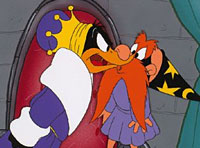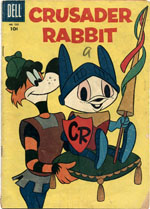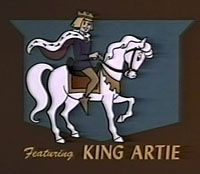 The mere thought of the King Arthur legend, of the knighthood, chivalry, and magic of it, never fails to bring to mind rich personalities and landscapes, and has thus had an enormous impact on all media. You would think, then, that the grand scope the legend provides might result in some enthralling animation. But as Michael N. Salda’s Arthurian Animation: A Study of Cartoon Camelots on Film and Television (McFarland) endlessly proves, the legend and the medium might be a mismatch.
The mere thought of the King Arthur legend, of the knighthood, chivalry, and magic of it, never fails to bring to mind rich personalities and landscapes, and has thus had an enormous impact on all media. You would think, then, that the grand scope the legend provides might result in some enthralling animation. But as Michael N. Salda’s Arthurian Animation: A Study of Cartoon Camelots on Film and Television (McFarland) endlessly proves, the legend and the medium might be a mismatch.
When Michael Salda contacted me a few years ago telling me of his plans for a book on Arthurian-themed animation, I was curious what he would come up with. As much as I love the legend (and the best thing to come out of it, Mark Twain’s A Connecticut Yankee in King Arthur’s Court), when I think of its connections to animation, “misfire” is the word that immediately comes to mind. (The Disney feature Sword in the Stone and the bomb Quest for Camelot being exceptional cases.)
Arthurian is very dense in description, and with good reason: there isn’t a whole lot in the cartoons for Salda to talk about otherwise. The book stands apart from a lot of academic animation studies in that the author is not afraid of voicing a critical assessment. A necessary requirement, considering Salda takes pains to trace the Arthurian elements found in the worst kiddie TV junk that he can’t pretend goes deeper than “Merlin was a magician.”
 Unintentionally no doubt, what Arthurian reveals most successfully is how the legend can be used to illustrate how a lot of bad animation tends to fall under two categories: cynic corporate waste and artistic overindulgence.
Unintentionally no doubt, what Arthurian reveals most successfully is how the legend can be used to illustrate how a lot of bad animation tends to fall under two categories: cynic corporate waste and artistic overindulgence.
Certainly Sword in the Stone falls somewhere in between. It’s too clumsy to be taken seriously, but too expertly crafted to dismiss out of hand. Knight-Mare Hare (embed below) is Jones working without Mike Maltese, his most important collaborator; his latent stuffiness is therefore not tempered and unleashed. The much later A Connecticut Rabbit in King Arthur’s Court suffers even more in this regard, but as Salda makes plain, Chuck Jones’s worst was as good as animation got in 1977 – not exactly a rousing endorsement, but there it is.
 The most interesting part of the book from a historical perspective, and what makes it worthy of at least a Kindle purchase, is the examination of Hugh Harman’s unproduced King Arthur feature (it went by at least three different names while in development). Salda used Harman’s papers verbatim for an enlightening look behind what he calls “the best Arthurian cartoon never made.” It was in development in the first half of the ‘40s and Harman was still trying to sell the screenplay as late as 1955. Being that he was untested in the feature realm, no one was interested in Harman’s project.
The most interesting part of the book from a historical perspective, and what makes it worthy of at least a Kindle purchase, is the examination of Hugh Harman’s unproduced King Arthur feature (it went by at least three different names while in development). Salda used Harman’s papers verbatim for an enlightening look behind what he calls “the best Arthurian cartoon never made.” It was in development in the first half of the ‘40s and Harman was still trying to sell the screenplay as late as 1955. Being that he was untested in the feature realm, no one was interested in Harman’s project.
 Harman was the Don Bluth of his day, an animator who never seemed to consider entertaining the audience as important as lush surfaces and upstaging Disney animation (and of course, always at a cheaper cost than the genuine article). Harman was determined his movie “retain as much of the authentic Arthurian data as possible,” but he also planned to employ musical interludes and hackneyed comic reliefs. If the movie was ever made, I’m sure it would have been at least as endearing as the Fleischer features, though like them, it’d only ultimately reaffirm Disney’s status as the sole maker of successful animated movies of that era.
Harman was the Don Bluth of his day, an animator who never seemed to consider entertaining the audience as important as lush surfaces and upstaging Disney animation (and of course, always at a cheaper cost than the genuine article). Harman was determined his movie “retain as much of the authentic Arthurian data as possible,” but he also planned to employ musical interludes and hackneyed comic reliefs. If the movie was ever made, I’m sure it would have been at least as endearing as the Fleischer features, though like them, it’d only ultimately reaffirm Disney’s status as the sole maker of successful animated movies of that era.
Undoubtedly many will find Arthurian a taxing read, particularly the unavoidable dryness of the second half as Salda descends into the wasteland of TV animation, but anything that brings new, accurate animation history to print is worth recommending for your reference library. The subtext, though, that one of the greatest legends has yet to find a balanced home in the greatest of collaborative media, is a bit unnerving. As Salda concludes, “the king and his court seem certain to continue to play roles in cartoons short and long for years to come.” Whether any of them will actually be any good – we have the answer in Salda’s book.
Here are two cartoons with Arthurian themes – from two extremes: Knight-Mare Hare (1955) by Chuck Jones and Horning In (1965) from Paramount, directed by Howard Post. Enjoy.


 THAD KOMOROWSKI is a writer, journalist, film restorationist and author of the acclaimed (and recently revised) Sick Little Monkeys: The Unauthorized Ren & Stimpy Story. He blogs at
THAD KOMOROWSKI is a writer, journalist, film restorationist and author of the acclaimed (and recently revised) Sick Little Monkeys: The Unauthorized Ren & Stimpy Story. He blogs at 

























































I always thought “Knight-Mare Hare” was a good cartoon. I get alittle tired of some people dissing Pierce just because his stuff wasn’t as elaborante as Maltese at this time.
I agree, Nic. “Knight-Mare Hare” may not be one of the most laugh out loud funny cartoonsever made but I find it consistently amusing, and that’s plenty for me.
“Hugh Harman was the Don Bluth of his time.”
Wow, I’ve never heard that one before, but its a very appropriate analogy!
“Chuck Jones’s worst was as good as animation got in 1977…”
Well, despite its flaws, Richard Williams’ often spectacular RAGGEDY ANN & ANDY was released in 1977.
To me it all seems the same anyway, face it, it was s dead time for animation when I was born.
Does the book mention the Australian TV series ARTHUR and the SQUARE KNIGHTS of the ROUND TABLE? It’s a kind of odd series. I actually found some episodes in a dollar public domain DVD (Eastwest video, I believe) under the name CAMELOT- during the opening sequence they even blank out the title card with a simply fonted “Camelot” title.
Eastwest DVD was pretty fly-by-night and often released stuff of dubious legalities.
Um, didn’t that wizard from “Horning In” appear in Honey Halfwitch cartoons?
So does the little “Silent Knight”. I think Post must had loved those characters so much he used them again in Honey Halfwitch.
What about “Prince Valient”, the series based on Hal Foster’s Arthurian comic strip? A big fan of Foster’s epic, I was disappointed with the series and never got beyond a few episodes.
On the one hand, the makers were clearly well-intentioned. Their primary goal was moral uplift (the lessons were generally thoughtful and not overtly religious), but they did respect their source material and production values were decent. Animation was more lavish than Filmation’s ambitious “Flash Gordon.”
On the other, it was. . . not that interesting. Kids might be intrigued, but fans of the strip would miss the violence, pultrichude and medieval grit. And most of all, they’d miss Foster’s sense of epic adventure, which came through even in a talking head panel.
Maybe Foster’s week-by-week saga just isn’t adaptable. The live-action movie is great unironic fun, American accents and all (Robert Wagner is pretty good, even with the wig). But it’s really more a standard swashbuckler than Foster’s immersive ode to Camelot.